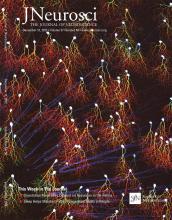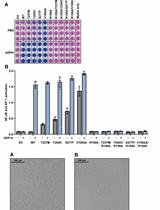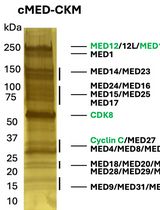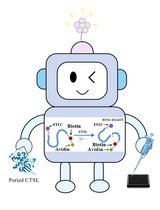- EN - English
- CN - 中文
Structural Analysis of Target Protein by Substituted Cysteine Accessibility Method
采用半胱氨酸取代法分析靶蛋白的结构
发布: 2018年09月05日第8卷第17期 DOI: 10.21769/BioProtoc.2470 浏览次数: 6294
评审: Anonymous reviewer(s)
Abstract
Substituted Cysteine Accessibility Method (SCAM) is a biochemical approach to investigate the water accessibility or the spatial distance of particular cysteine residues substituted in the target protein. Protein topology and structure can be annotated by labeling with methanethiosulfonate reagents that specifically react with the cysteine residues facing the hydrophilic environment, even within the transmembrane domain. Cysteine crosslinking experiments provide us with information about the distance between two cysteine residues. The combination of these methods enables us to obtain information about the structural changes of the target protein. Here, we describe the detailed protocol for structural analysis using SCAM.
Keywords: Cysteine (半胱氨酸)Background
Structural analyses provide the critical information about the function of a target protein. X-ray crystallography and nuclear magnetic resonance have been utilized as high-resolution protein structural analysis methods in the biology field. However, these methods require a purified protein extracted from membrane at very high concentration for the structural analysis of membrane proteins. Substituted Cysteine Accessibility Method (SCAM) is a biochemical approach to analyze the water accessibility and the spatial distance of particular cysteine residues substituted in the target protein. Using methanethiosulfonate (MTS) reagents that specifically react with the cysteine residues facing the hydrophilic environment, we can annotate the topology and structure of the target protein. As the labeling reagent N-biotinylaminoethyl methanethiosulfonate (MTSEA-biotin) is impermeable to the plasma membrane (Seal et al., 1998), in intact cells, only extracellular, but not intracellular, cysteine residues are biotinylated (Figure 1A). In contrast, both extracellular and intracellular cysteine residues are exposed to the hydrophilic environment in microsomes and are biotinylated by MTSEA-biotin (Figure 1B). Moreover, the accessibility of cysteine can be analyzed by competition experiments using membrane-impermeable MTS derivatives (Figure 2A). By combining the results of these analyses, we are able to obtain structural information of the entire intrinsic protein in the membrane (Akabas et al., 1992; Loo and Clarke, 1995; Frillingos et al., 1998; Karlin and Akabas, 1998; Foucaud et al., 2001; Kaback et al., 2001; Bogdanov et al., 2005; Sato et al., 2006 and 2008; Takagi et al., 2010; Watanabe et al., 2010; Takagi-Niidome et al., 2015; Tominaga et al., 2016; Cai et al., 2017; Tomita, 2017). The accessibility of cysteine can be analyzed in more detail by competition experiments using membrane-impermeable MTS derivatives; the negatively charged 2-sulfonatoethyl methanethiosulfonate (MTSES), the positively charged 2-(trimethylammonium)-ethyl methanethiosulfonate (MTSET), and the sterically bulkiest 2-(Triethylammonium)-Ethyl Methanethiosulfonate Bromide (MTS-TEAE) (Figure 2A). Moreover, cross-linking experiments using microsome fractions provide information regarding the spatial distance between two separated cysteines in different polypeptides (Figure 3A) (Loo and Clarke, 1996; 2000; 2001; Klco et al., 2003). In this experiment, all endogenous cysteines of the target protein should be mutated by serine or alanine (cys-less mutant), and then one (single cys-mutation) or two (double cys-mutation) target residues would be substituted to the cysteine to analyze the accessibility of particular residue(s) by MTS reagents. However, sometimes these substitutions affect the structure and function of the target protein. Thus, it is important to analyze the biological function of the target protein to ensure whether the mutations do not affect the protein conformation.
Materials and Reagents
- QSP 0.1-10 μl PIPETTE TIP (Thermo Fisher Scientific, Quality Scientific Plastics, catalog number: 102-Q )
- 1-200 μl New Pipette Tip Yellow (Thermo Fisher Scientific, Quality Scientific Plastics, catalog number: TW110-Q )
- 101-1,000 μl Pipette Tip Blue (Thermo Fisher Scientific, Quality Scientific Plastics, catalog number: 111-Q )
- 1,000-5,000 μl Pipette Tip Natural (Thermo Fisher Scientific, Quality Scientific Plastics, catalog number: 090-Q )
- 15 ml centrifuge tube (IWAKI, catalog number: 2325-015 )
- 12-well flat bottom microplate (IWAKI, catalog number: 3815-012 )
- 150 mm tissue culture dish (IWAKI, catalog number: 3030-150 )
- 1 ml syringe (TERUMO, catalog number: SS-01T )
- 27 G needle (TERUMO, catalog number: NN-2719S )
- MEF cells
- Immunostar® Reagents (Immunostar; Wako Pure Chemical Industries, catalog number: 291-55203 )
- SuperSignalTM West Femto Maximum Sensitivity Substrate (Supersignal; Thermo Fisher Scientific, catalog number: 34096 )
- Streptavidin SepharoseTM High Performance (SA beads; GE Healthcare, catalog number: 17511301 )
- Disodium hydrogenphosphate 12-Water (Na2HPO4•12H2O; Wako Pure Chemical Industries, catalog number: 196-02835 )
- Sodium dihydrogenphosphate Dihydrate (NaH2PO4•2H2O; Wako Pure Chemical Industries, catalog number: 192-02815 )
- Potassium chloride (KCl; Wako Pure Chemical Industries, catalog number: 163-03545 )
- Sodium chloride (NaCl; NACALAI TESQUE, catalog number: 31320-34 )
- Potassium dihydrogen phosphate (KH2PO4; Wako Pure Chemical Industries, catalog number: 169-04245 )
- Copper(II) sulfate (CuSO4; Wako Pure Chemical Industries, catalog number: 034-04445 )
- Sodium Dodecyl Sulfate (SDS; NACALAI TESQUE, catalog number: 31606-04 )
- 1,10-Phenanthroline monohydrate (Phenanthroline; Wako Pure Chemical Industries, catalog number: 169-00862 )
- N-Ethylmaleimide (NEM; NACALAI TESQUE, catalog number: 15512-11 )
- cOmpleteTM Protease inhibitor cocktail (Roche Diagnostics, catalog number: 11836145001 )
- 2-[4-(2-Hydroxyethyl)-1-piperazinyl] ethanesulfonic acid (HEPES; Dojindo Molecular Technologies, catalog number: GB10 )
- O,O'-Bis(2-aminoethyl)ethyleneglycol-N,N,N',N'-tetraacetic acid (EGTA; Dojindo Molecular Technologies, catalog number: G002 )
- Sucrose (Wako Pure Chemical Industries, catalog number: 196-00015 )
- Tris (hydroxymethyl) aminomethane (Tris; C4H11NO3; STAR CHEMICAL, catalog number: RSP-THA500G )
- Glycerol (Wako Pure Chemical Industries, catalog number: 075-00616 )
- Brilliant Green (Wako Pure Chemical Industries, catalog number: 021-02352 )
- Coomassie Brilliant Blue G-250 (CBB G-250; NACALAI TESQUE, catalog number: 09409-42 )
- DMEM, high glucose, no glutamate, no methionine, no cysteine (DMEM (cys-); Thermo Fisher Scientific, catalog number: 21013-024 )
- Dimethyl sulfoxide (DMSO; Wako Pure Chemical Industries, catalog number: 045-28335 )
- 2-mercaptoethanol (Wako Pure Chemical Industries, catalog number: 139-07525 )
- N-Biotinylaminoethyl Methanethiosulfonate (MTSEA-biotin; Toronto Research Chemicals, catalog number: B394750 )
- Sodium 2-Sulfonatoethyl Methanethiosulfonate (MTSES; Toronto Research Chemicals, catalog number: S672000 )
- 2-(Trimethylammonium)-Ethyl Methanethiosulfonate Bromide (MTSET; Toronto Research Chemicals, catalog number: T795900 )
- 2-(Triethylammonium)-Ethyl Methanethiosulfonate Bromide (MTS-TEAE; Toronto Research Chemicals, catalog number: T775800 )
- 1,2-Ethanediyl Bismethanethiosulfonate (M2M; Toronto Research Chemicals, catalog number: E890350 )
- 1,3-Propanediyl Bismethanethiosulfonate (M3M; Toronto Research Chemicals, catalog number: P760350 )
- 1,4-Butanediyl Bismethanethiosulfonate (M4M; Toronto Research Chemicals, catalog number: B690150 )
- 1,6-Hexanediyl Bismethanethiosulfonate (M6M; Toronto Research Chemicals, catalog number: H294250 )
- 3,6-Dioxaoctane-1,8-diyl Bismethanethiosulfonate (M8M; Toronto Research Chemicals, catalog number: D486150 )
- Undecane-1,11-diyl-bismethanethiosulfonate (M11M; Toronto Research Chemicals, catalog number: U787800 )
- 3,6,9,12-Tetraoxatetradecane-1,14-diyl-bis-methanethiosulfonate (M14M; Toronto Research Chemicals, catalog number: T306250 )
- 3,6,9,12,15-Pentaoxaheptadecane-1,17-diyl Bis-methanethiosulfonate (M17M; Toronto Research Chemicals, catalog number: P273750 )
- 1x Phosphate Buffered Saline (1x PBS; see Recipes)
- 1x Dulbecco's Phosphate Buffered Saline (1x DPBS; see Recipes)
- 1x Sample buffer (sample buffer; see Recipes)
- 1x homogenize buffer (see Recipes)
Equipment
- 0.5-10 μl Pipettor (NICHIRYO, model: Nichipet EXII, catalog number: 00-NPX2-10 )
- 2-20 μl Pipettor (NICHIRYO, model: Nichipet EXII, catalog number: 00-NPX2-20 )
- 20-200 μl Pipettor (NICHIRYO, model: Nichipet EXII, catalog number: 00-NPX2-200 )
- 100-1,000 μl Pipettor (NICHIRYO, model: Nichipet EXII, catalog number: 00-NPX2-1000 )
- 1,000-5,000 μl Pipettor (NICHIRYO, model: Nichipet EXII, catalog number: 00-NPX2-5000 )
- Forma Series II Water Jacket CO2 Incubator (Thermo Fisher Scientific, catalog number: 3110 )
- Polytron homogenizer (Hitachi, model: HG30 )
- 500-Watt ultrasonic processor (Sonics & Materials, model: VCX 500 )
- Small size culture rotator (TAITEC, model: RT-50 )
- High speed centrifuge (Koki Holdings, himac, model: CF15RN )
- High speed refrigerated micro centrifuge (TOMY, model: MX-307 )
- Ultracentrifuge (Beckman Coulter, model: Optima L-90K )
- Ultracentrifuge fixed angle rotor (Beckman Coulter, model: Type 50.4 Ti , catalog number: 347299)
- Aluminum block bath (TAITEC, model: DTU-1CN )
- ImageQuant LAS 4000 (GE Healthcare)
- Centrifuge tube (Beckman Coulter, catalog number: 355645 )
- Spatula
Software
- ImageQuant TL 7.0 (GE Healthcare)
Procedure
文章信息
版权信息
© 2018 The Authors; exclusive licensee Bio-protocol LLC.
如何引用
Readers should cite both the Bio-protocol article and the original research article where this protocol was used:
- Cai, T. and Tomita, T. (2018). Structural Analysis of Target Protein by Substituted Cysteine Accessibility Method. Bio-protocol 8(17): e2470. DOI: 10.21769/BioProtoc.2470.
- Cai, T., Yonaga, M. and Tomita, T. (2017). Activation of γ-secretase trimming activity by topological changes of transmembrane domain 1 of presenilin 1. J Neurosci 37(50): 12272-12280.
分类
生物化学 > 蛋白质 > 结构
生物化学 > 蛋白质 > 活性
您对这篇实验方法有问题吗?
在此处发布您的问题,我们将邀请本文作者来回答。同时,我们会将您的问题发布到Bio-protocol Exchange,以便寻求社区成员的帮助。
提问指南
+ 问题描述
写下详细的问题描述,包括所有有助于他人回答您问题的信息(例如实验过程、条件和相关图像等)。
Share
Bluesky
X
Copy link












